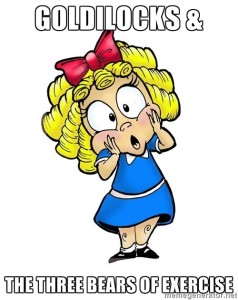
by drmiranda | Mar 9, 2016 | diet, weight loss
Goldilocks and the three bears of exercise… Once upon a time Goldilocks went to a nice doctor in Louisiana because she had a serious muffin top and no matter what she did, she couldn’t budge it. Goldilocks told the nice Doctor, “I used to not exercise at all, and I got fat! But then, I started running marathons through the woods, and I still stayed fat! I exercise more than I ever have in my life, and nothing helps! Tell me Doctor, what can I do?”
The Doctor replied, “Well, Goldilocks, just like the best porridge is neither too hot nor too cold, the same goes for exercise. You do have to ‘move it to lose it’ but you don’t want to over-do it with sustained exercise. You see, exercise makes the muscles release a compound called IL-6. This IL-6 goes to your brain and signals it to tone down your hunger. It goes to your liver and tells it to balance out your blood sugar fluctuations better. It goes to your fat cells and tells them to burn more fat. But life is not all comfy begs and toasty porridge. There are two key types of exercise – A) Sustained duration exercise, like your running through the woods, and B) short duration, high intensity exercise. Like those 5-10 minute microburst sessions where you have to get away from those scary bears!. Long periods of exercise induce chemical reactions which negate the benefits of IL-6, and they increase stress hormones, like cortisol, which can make it much, much harder to burn fat. It is the short microburst activity, like High Intensity Interval Training (HIIT) or weight training, that shuts down the production of the inflammatory compounds and aging compounds your fat cells produce . They also elevate your metabolic rate, and even stimulate your thyroid health. HIIT is MUCH better than sustained exercise if your goal is to burn fat! So Goldilocks, we need to find the ‘just right’ level of exercise for your body. This means when you exercise, you are going to give it your all for very short periods of time, 45 seconds! then work slowly for a minute, then do another 45 second burst of intense activity. Do this 5-10 times, so you end up doing 10-15 minutes of physical activity, and do this once a day. You can do this twice a day if you really want to. This will make your body burn fat for hours and hours! Bye-bye muffin top, hello skinny lederhosen!”
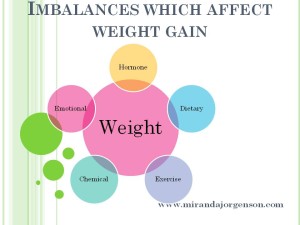
by drmiranda | Oct 20, 2015 | chiropractic, diet, dietary supplements, gallbladder, not losing weight, weight loss
THERE IS NO MAGIC BULLET WHEN IT COMES TO WEIGHT LOSS! That is why there is NO SINGLE THING that will work for everyone. There are simply too many factors involved. That said, we can encompass these factors into key categories: Dietary, Hormonal, Chemical, Exercise, and last but not least – Emotional. Dietary factors are the easiest to explain – you have to feed your body real food and provide it with nutritionally sound fuel if you want it to function at a decent level. You wouldn’t put bad gas in your car and expect it to run well, the same can be said for your body. The second imbalance is hormonal – while we have dozens of hormones that readily affect our weight, with women, thyroid, adrenal, or sex hormone imbalances are the most common culprits. Chemical imbalances are both the easiest and the hardest to change. You have control over the chemicals you expose your body to, you may not have as much control over the medications you take. Nearly every drug that is prescribed not only induces specific vitamin and mineral depletions, but many are highly toxic and have a plethora of side effects. There is a long list of medications that not only impair weight loss but can cause weight gain. If you are on prescribed medications which are associated with weight issues- speak to your prescribing physician to see if there are better options (with fewer side effects) available to you. Exercise is the factor which everyone underestimates. Now, I don’t think you need to run marathons or bench press your weight, but most people think they exercise far more than they do. Get a pedometer and keep a record of your physical activity. Walking is one of the best activities you can do. If you can handle more, look into HIIT, yoga, swimming, or even mild weights. Chiropractors are always fond of the saying, “move it or lose it” – if you are not actively moving your joints, you accelerate the aging process, and your strength and flexibility will decrease at a fairly consistent rate. Lastly – lets look at emotional factors. There is a HUGE emotional component to weight loss (and to allergies, but I will save that conversation for another day). Some of us get comfort from food. Some of us were conditioned as children to ‘clean our plates’, some are addicted to fats and sweets. Women that are nurturing and caregivers tend to struggle with weight more than those that are not care givers. Some use fat as an insulation against emotions. Some of us mentally *see* ourselves as a big girl, and can’t even imagine ourselves thinner. Some of us have given up hope.

Let me be very blunt – no one will ever reach and maintain their ‘happy weight’ unless all of these factors are balanced. You might lose and regain the same 15 (or 40) lbs over and over, but you will not be able to maintain it. As a chiropractor, I am trained in balancing the body – that is what we do. We balance it so it works correctly. Moving into the weight loss realm isn’t that much different – you will notice that everything I suggest or recommend isn’t extreme, it is practical & doable. I focus on helping you achieve balance – and I give you simple tools to accomplish that. It could be supplements to balance what your gallbladder should be doing. It could be supplements which balance your body chemistry so you can enhance your metabolism. It may be easy activities like walking to increase your cardiovascular fitness and lymph flow. I may suggest you speak to your physician about certain medications, and I may even suggest other things which impact those emotional factors.
Weight loss is a process, your happy weight is the destination. The road isn’t easy, but it isn’t hard either – it just requires consistent effort. The process doesn’t usually occur at warp speed, but you didn’t accumulate those impairments to your health overnight either. I have dedicated my life to helping people – and if YOU don’t give up on you, I won’t either! Anyone who purchases products from me, whether it is Beta, Vitamin D, – or anything else, becomes my personal client. I send you my personal phone number, my email, and make myself completely accessible to you. I will help you reach your goals, but I want you to know that I can’t do the work for you – only steer you in the right direction. You are always in control of your own destiny.
So, as you’ve read this, and are contemplating your own situation, ask yourself if you are balanced. Are you focusing all of your efforts on one factor and ignoring the rest? If you make a concerted effort to achieve balance in all of these 5 factors, I can absolutely guarantee you that you will achieve your happy weight and never leave it again!

by drmiranda | Sep 22, 2015 | gallbladder, health, weight gain, weight loss
This basic principle applies to any surgery , albeit different organ systems are affected, but for our purposes, we will relate this to gallbladder surgery (cholecystectomy).
ANY time you have surgery (of any sort) you can experience fatigue. Your body only heals when you are asleep – so that is nature’s way of getting you to slow down – so you can heal efficiently [while sleeping]. That said, most people didn’t go into surgery with a fully functioning gallbladder. It could have been dysfunctional or essentially non-functioning for months or even years before that. So , that means you have months or years of digestive issues and not getting the building blocks your body needs to make hormones or repair itself. Surgery brings its own issues, as it increases the demand you have for certain nutrients – like vitamin C, B vitamins, protein, glutathione, etc . So, when you have gallbladder surgery – you go from just being deficient in the fat soluble vitamins (A,D,E,K) and essential fatty acids to being potentially deficient in most of the major vitamin categories. To compound matters, they typically put you on a significant dose of antibiotics after your surgery – which kills off the good bacteria in your gut along with the bad, and since 80% of you immune function comes from the gut and those good bacteria, your immune function goes down , making your MORE tired and susceptible to catching everything that goes around. It is a hard thing to dig yourself out of. You have to overhaul your diet (and you rarely get that advice), you have to get optimal levels of sleep, and you have to get out in the sunshine and fresh air and get some exercise. Otherwise you feel like you are trying to dig yourself out of a hole with a plastic spoon. Now, occasionally people feel great after surgery, but they are the exception to the rule. In 12 years of practice, I have rarely met anyone who didn’t have to make changes to feel better afterwards. Sooner or later their underlying nutritional deficiencies caught up to them and affected their health.
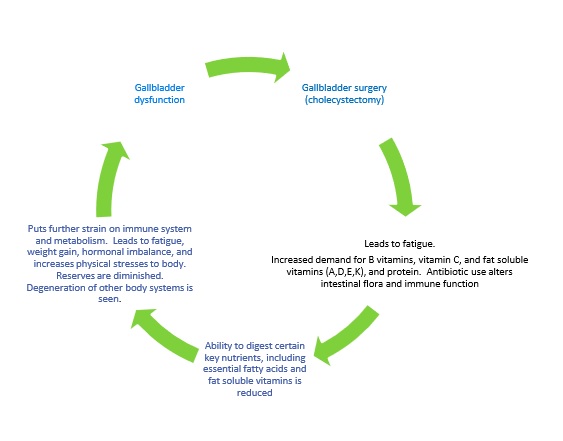
Your body uses cholesterol and vitamin D as precursors to make many of your hormones, including your sex hormones. Fats are necessary for life, and your brain is largely a fatty organ. This is why people taking anti-cholesterol medications (statins) frequently experience decreased libido, or even sexual dysfunction. They also often experience short term memory issues. 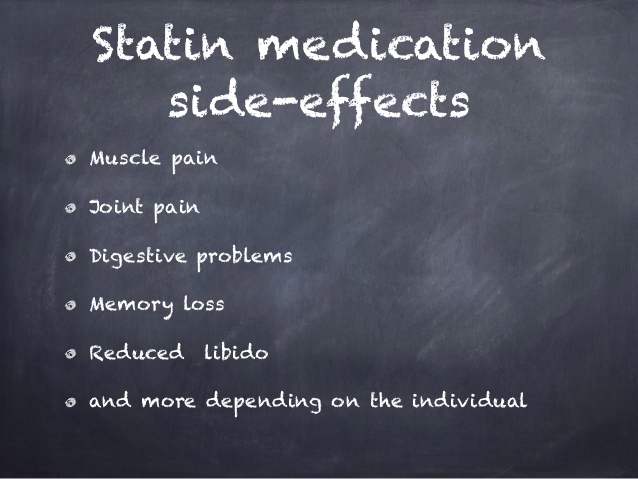
I have heard doctors argue that the gallbladder is unnecessary. They say that since the liver continues to make bile, then fat absorption continues. I disagree with this. First, I don’t believe we were designed with unnecessary parts. We may not realize their full worth or function yet, but that is a human limitation, not a limitation of our creation. Science only ‘discovered’ what the appendix was for within the past few years (It acts as a reservoir for healthy bacteria to recolonize our intestines after fever or illness). Since cholecystectomy is one of the most commonly performed surgical procedures in this country, it makes sense that there is more money in removing them than figuring out how to save them. But I digress, let’s get back to the liver making bile – it does keep making it. The level it makes it is dependent on whether you have fatty liver degeneration or not. But let’s say that you don’t have fatty liver — the liver is going to drip, drip, drip 27-34 oz bile out in a steady stream. That bile is very caustic, and would normally be funneled over to the gallbladder where it is collected and concentrated, up to 18 times – down to 1-3 oz. It is this highly concentrated bile that is designed to break down the fatty acids and fat soluble vitamins you consume. The pre-concentrated bile, while caustic and irritating to your gastric mucosa, can’t hold a candle to the concentrated bile your gallbladder should hold. There is never enough, and never enough at the specific concentration required to absorb those key nutrients out of your diet. So you become deficient and your body goes into conservation mode. Some experience this immediately, others find it takes 6-24 months to fully start experiencing the effects. People find it harder and harder to lose weight, or they find themselves gaining weight despite eating the same diet they always did, or exercising. They find they get fatigued easier, and that they are more susceptible to colds and flu. If they have autoimmune disorders, they may find themselves experiencing a greater degree of symptoms.
So what can you do? I will be the first to admit that I don’t have all of the answers. If anyone suggest that they do – RUN! I can tell you that what my research, and my experience has led me to works for most people. First, you need to keep a food journal and track every meal you eat and how you feel afterwards. Gas, bloating, and diarrhea are the most commonly experienced repercussions from having cholecystectomy. 1 in 15 people who have had their gallbladder removed experience Habba Syndrome, which is commonly misdiagnosed as IBS, or even Celiac Disease. 5-40% of cholecystectomy patients will experience post-cholecystectomy syndrome (persistent right upper quadrant abdominal pain, bloating, gas, nausea, diarrhea, and general malaise). Often, these people will know the whereabouts of every bathroom in their vicinity, because they experience issues almost immediately after eating. Dietary changes will be necessary. Certain foods aggravate a significant number of people with no gallbladder. These include greasy foods, carbonated beverages, dairy, and simple carbohydrates. Wheat products, including breads and beer, can also elicit a negative response. Please don’t take this as a reason to stop eating healthy fats — you NEED to consume them in order to maintain your health and shift your waistline. Use specific dietary supplementation to replace some of the action of the gallbladder. I recommend a blend of ox bile, beet concentrate and pancrelipase to substitute for this action. If you avoid fats, you will make matters worse. Since digestive enzyme production decreases with age, if you are over 40, adding digestive enzymes to your meals can also cause significant relief. make sure you are getting adequate levels of sleep so that your body can repair itself and so that levels of stress hormones can decrease.
- Keep a food journal to log your physical responses to foods and beverages. Learn what your body can and cannot handle.
- Use specific dietary supplements to increase your digestion and resolve your underlying nutritional deficiencies.
- Get 7+ hours of uninterrupted sleep per night.
- Get out there and move. Aerobic activity and weight bearing exercise is crucial for your recovery. Walking is a great way to get started. Walking in the sunshine is even better (get some vitamin D while you are at it!)
Image courtesy of Ohmega1982 at FreeDigitalPhotos.net
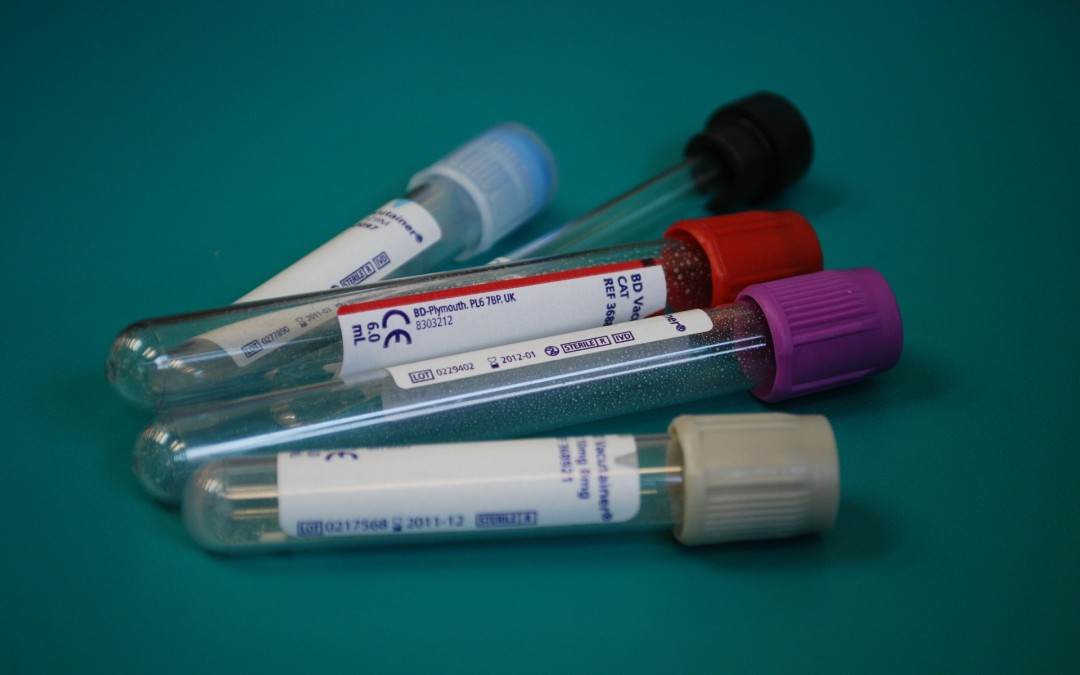
by drmiranda | Sep 1, 2015 | blood test, fatigue, health, hypothyroid, inflammation, insulin resistance, not losing weight, obesity, weight loss
You’ve heard about preemptive strikes, how about preemptive health? Don’t wait until you are really sick to get blood work drawn. Have it drawn at your yearly physical and keep a copy for your records. You OWN your medical records, by the way, your physician is just the custodian of them – so you are legally entitled to a copy of anything contained within it.
PREEMPTIVE HEALTH: What Blood Work to Request from Your Doctor
I get a lot of requests from people asking what blood tests they should request at their next medical appointment. Along with getting a standard Chemistry Panel and Complete Blood Count (CBC) which should include RBC Magnesium and RBC Potassium , here are the ones I commonly recommend for women. Men would have a few slight differences.
1) Complete Thyroid Panel :
TSH (many doctors only test TSH, and that is like trying to diagnose what is wrong with your foot by only looking at your big toe)
Free T3 (also known as: Triiodothyronine, Free)
Free T4, Direct S (Not Free T4 Index, Free T4 calculated, or TSH reflux)
Reverse T3 (If your doctor will do this and/or if it’s available in your country)
***Because this test includes a TSH screening, remember that medications like corticosteroids, aspirin and lithium can interfere with those results. Also, if you’ve had a recent X-ray that used iodine dye – or other radioactive tests – ask your doctor when you can take an accurate TSH test. Pregnant women in their first trimester should also ask their doctor about the proper time to get a TSH test.
If you have symptoms of hypothyroidism and/or Hashimoto’s Disease, add these :
Thyroid Peroxidase Antibody (TPOab)
Anti-Thyroglobulin (TgAb)
If you have symptoms of hyperthyroidism (much less common), add these:
Thyroid Stimulating Immunoglobulin (TSI)
Thyroid Receptor Antibody (TrAb)
2) Iron panel:
Serum iron
Total Iron Binding Capacity (TIBC)
%Saturation
Ferritin
3) Vitamins:
B12
D3
4) Sex Hormones (serum blood):
Testosterone
Estradiol
Progesterone
FSH
LH
DHEA
***The sex hormone tests should be done 7 days after ovulation. If you don’t know when you ovulate, an ovulation kit can be purchased from a drugstore, or you can just test on day 21, if you still menstruate. If you no longer cycle, the tests can be done anytime.
5) Other tests:
C-Reactive Protein (systemic inflammation marker)
Cholesterol panel ( I don’t care if it is high, I look at the ratios, and your CRP level^^^)
Fibrinogen (clotting & inflammation marker)
Hemoglobin A1C (long term measure of glucose status)
Homocysteine ( risk for coronary artery disease, fractures, and other disorders)
################################################################################################
A) If you have ANY chronic health conditions, I recommend getting an ELISA Food Sensitivity and Allergy Panel done. It is an easy way to identify what you consume that is contributing to your systemic inflammation. Most family doctors do not perform these tests, you will need to go to someone familiar with them. ALCAT and ALLETESS are the two brands of testing that I have used with my patients. Their respective websites can help you locate a practitioner who is versed in them www.alcat.com , www.foodallergy.com
B ) If you have symptoms of low cortisol/ or adrenal fatigue, then salivary cortisol tests should be considered. Cortisol levels: 24-hour saliva cortisol tests from Canary Club and MyMedLab are done through ZRT Laboratories: http://www.canaryclub.org/diurnal-cortisol-4x-stress-hormone-kit.html ($119+shipping) or https://sttm.mymedlab.com/sttm-profiles/sttm-24-hour-cortisol-dhea ($125)
Symptoms of low cortisol: http://www.stopthethyroidmadness.com/adrenal-info/symptoms-low-cortisol/
C) Educate yourself! Read up on what you are experiencing: Books I highly recommend: Type II Hypothyroidism, Dr. Mark Starr; Stop the Thyroid Madness, Janie Bowthorpe; What is Your Menopause Type? Joseph Collins ; Death to Diabetes, DeWayne McCulley, The Blood Sugar Solution, Dr. Mark Hyman; The Adrenal Reset Diet, Dr. Alan Christianson; Hashimoto’s Thyroiditis, Wentz & Nowasadzka.
©2015, MirandaJorgenson, www.mirandajorgenson.com
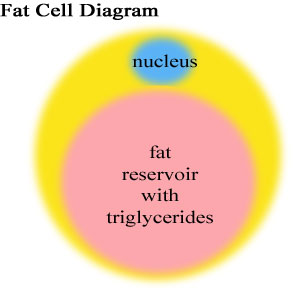
by drmiranda | Jul 15, 2015 | blood supply, diet, dietary supplements, fat breakdown, fatigue, health, insulin resistance, lipolysis, not losing weight, plateau, walking, water retention, weight gain, weight loss
This is an aspect of weight loss that perplexes a lot of people – they start a new diet and notice their clothes getting looser, or their face getting thinner – but their weight is staying the exact same! It is frustrating, because you *think* your diet is working but you step on the scale and feel like a big old failure.
Well, I am here to tell you that you can relax! You are not a failure! You are experiencing the wonders of the fat cell in action (I can hear you saying, “big whoop — skinny thighs are what excites me!”).
Let’s start off with a little physiology lesson. In your body you have 10-30 billion fat cells, and that is if you are of a healthy weight. Overweight people can have 75 billion fat cells or more, and it is not unheard of for morbidly obese people to have 250-300 billion fat cells overwhelming their boney frames! That is a LOT of fat cells (adipocytes). Picture each fat cell like a little deflated balloon. That balloon can be relatively empty or filled to the brim and be stretched over 10x its normal size. Now these fat cells are stubborn creatures – you can always make more, but once you have them, they are yours for good. Up until very recently1, it was thought that the only way to get rid of fat cells was to cut them out, but you can deflate them — and this is the key to losing weight effectively.

You see, fat cells are little storage tanks, and despite your most heartfelt desires to the contrary, they are remarkably efficient at storing fat in the form of triglycerides within the cell. When we want to burn fat – it isn’t an easy matter of having your brain tell your body, “we need more energy – let’s burn that love handle”. It doesn’t work that way! We need two enzymes, hormone sensitive lipase and adipose glyceride lipase to break down the triglyceride within fat cell where it is then released into the bloodstream as FFA’s. The more blood supply an area has, the better it can whisk away those FFA’s that are getting dumped from the fat cells. You can see this on your own body — take a second and poke your facial cheeks. See, the fat there is nice and soft because it has a good blood supply. Now grab the fat on your belly or on your butt. Feel the difference? It is dense and hard. It doesn’t have a good blood supply to whisk fat away. This is why when you start losing weight, it usually leave the ‘soft’ places first – your face, breasts, and arms and leaves you feeling like a saggy humpty dumpty for a while. This blood flow issue also leads us to our key point – when you start a diet and are burning fat, the scale often stays immobile despite you noticing that you are shrinking. This happens because the body abhors a vacuum. When the adipocytes dump out their fatty contents, your body doesn’t like to see an empty cell – so it shuttles water into the cell to fill up the space the fat just occupied. This is also why fat loss can be considered an inflammatory process and why you often feel bad, tired, sick, or swollen when you are dieting (there are other chemical factors, but we will discuss those at another time). Your body is literally replacing the fat with water! This process is more extreme for some people than for others, and some fortunate souls experience very little of this water replacement. This is also why your stomach or thighs can feel mushy or spongy when you are losing weight – you are replacing a dense fat with water.
So, what you can do, especially if you know that you have resilient fat or are a water hoarder? Well, there are a few simple things:
- Stay hydrated. I know, you’re thinking, “Why put more water into a swollen body?”, — Well, you need to flush out the metabolites from breaking down those FFA’s.
- Limit Caffeine and Alcohol. A little of either substance is OK, and small doses of caffeine can even be beneficial because it has a mild diuretic effect. Large amounts of either (and by large I am referring to more than 3 caffeinated beverages or more than 1 glass of wine or beer each day) can cause you to swell up like a balloon at the Macy’s Day Parade AND make your hard-earned weight loss come to a grinding halt.
- Shake your booty. Yes, I said it. The largest lymphatic pump in your body is the quadriceps muscles in your legs, so anything that gets those quads pumping — like walking, dancing, or biking, increases your lymph flow and your blood flow. If you work yourself up to a decent exertion point, then you will really increase systemic blood flow, and breathing (and breathing is the means by which your body excretes the metabolites of burnt fat cells!). Dig out those Richard Simmons’ shorts you’ve been hanging onto for the past 20 years — (they are back in style) and get ‘Sweatin’ to the Oldies!’
So there you have it! Know that you are not hallucinating – your face is thinner, your breasts are shrinking, and those bingo wings are real. Your scale just hasn’t caught up with your body! The more you follow the above steps – the faster you will purge that excess water (and inflammation) and the scale will start moving in the right direction.
1.http://www.nytimes.com/2008/05/05/health/research/05fat.html?_r=0
by drmiranda | May 12, 2015 | Uncategorized, weight loss
Did you know that calcium absorption is a major issue for bariatric patients? Approximately 85% of all calcium supplements sold in the United States contain calcium carbonate (also known as limestone, or chalk) – and this form of calcium is rarely recommended for bariatric patients because of several key features: 1) it acts as a functional antacid, 2) it requires a highly acid environment to be absorbed, and 3) as a direct result of surgical alteration of stomach size – most people will no longer have the physical capability to absorb any of the elemental calcium from it.
The two forms of calcium that bariatric patients hear bantered about most frequently are CALCIUM CITRATE and CALCIUM LACTATE. Both of these are excellent sources of calcium, however, one has a distinct advantage over the other. If we are speaking about the best form of tableted calcium for people who have not had surgical alteration of their GI tract – then I would agree that calcium citrate pills are ideal. However, when you take into account how bariatric surgery affects the stomach and/or small intestine, and knowing that a large percentage of bypass surgeries involve bypassing at least part of the duodenum (which is where calcium is normally absorbed) – then calcium lactate becomes the winner.
Furthermore, calcium is a bulky mineral. You have to take a lot of it to be able to absorb the percentage you actually need. That is why calcium tablets are usually fairly big. Knowing this, vitamin manufacturers have two choices when they configure their supplements – they can either divide the dose into multiple tablets or capsules, or they can compress it into one or two giant ‘horse’ pills and compress them to the point that they are veritable cement bullets. This leaves bariatric patients in a catch-22, — they usually do not want to feel full and bloated from taking a lot of pills, but they also know if they take one of the highly compressed tablets, that they will likely absorb very little from it.
The solution is to take powdered calcium, and the ideal form of powdered calcium is calcium lactate. Calcium lactate is considered to be one of the most neutral forms of calcium. It is not chalky or soapy like calcium carbonate, and it lacks the bitterness of calcium citrate. If you need a calcium that is readily absorbed, and has a high solubility factor, which means that you can easily mix it into any beverage you so choose — then calcium lactate is the one to choose. It is significantly more soluble over other forms so you can fit a larger dose in a smaller serving size. Naturally gentle on the stomach, powdered calcium lactate provides the most available surface area for absorption once it passes into the small intestine.
That isn’t to say that you can’t get calcium citrate in powdered form. There are a few commercial preparations that use it, but powdered citrate does not mix readily into beverages. If you put a spoonful of it into a glass of water, you would have to stir and guzzle the contents very quickly or you would lose a significant amount as it would settle to the bottom of the glass or stick to the sides. Having to chug a big glass of bitter, gritty calcium, 2-3 times a day may not be appealing to many people.
That said, it is my belief that most Americans do not have a calcium issue. Per capita, American’s has one of the highest calcium consumption rates in the world yet they have one of the highest rates of osteoporosis. This tells me that we don’t have a calcium issue, but a magnesium and co-factor issue. We know that 80% of women are magnesium deficient. If you are going to supplement with calcium, please speak to your physician about adding a magnesium supplement to your regimen. Vitamin C enhances the absorption of both calcium and magnesium, so they are good nutrients to pair together. My office carries a supplement which contains a balanced ratio of calcium, magnesium, and vitamin C. Please contact us for details.








